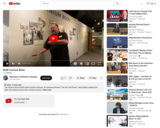To prepare for this project / assignment, students could view the 'A Civil Action' movie, the instructor could read to them excerpts from the book and/or the trial testimony, and show them images from Woburn, wells G and H, the subsurface geologic materials, geologic cross sections, the trial participants, and the federal courtroom in Boston (see below). The materials in Bair (2001) about scientists in the courtroom, specific (excerpted) testimony presented by the three expert witnesses in the 'A Civil Action' trial, a chart summarizing the differences in their testimony, and the views of a federal judge on the goal of science versus the goal of a civil trial may also be worthwhile reading by the class prior to the assignment.
The instructor could show students the large plates included in the USGS report by Myette and others (1987) that display potentiometric data and contours before and after the critically important aquifer test performed in December 1985 and January 1986, just before the trial, and discuss the significance of the stream discharge measurement made by the USGS upstream and downstream of municipal wells G and H to the experts' testimony and the outcome of the trial.
The instructor could also show the animations of TCE movement from 1960 to 1986 from the five known sources of TCE contamination at the Woburn Wells G & H Superfund Site (W.R. Grace, UniFirst dry cleaners, Olympia Trucking, Beatrice Foods, and New England Plastics) and the animation showing temporal changes in induced infiltration from the Aberjona River to wells G and H that were created by Martin van Oort (M.S., 2005) based on the research of Maura Metheny (M.S., 1998; Ph.D., 2004) at Ohio State University.
The article by Bair and Metheny (2002) concerning the remediation activities subsequent to the famous trial at the Wells G & H Superfund Site could be used to show how groundwater contamination is cleaned up, why different remediation schemes needed to be used in different hydrogeologic settings, and why cleanup to U.S. EPA standards can take decades.
(Note: this resource was added to OER Commons as part of a batch upload of over 2,200 records. If you notice an issue with the quality of the metadata, please let us know by using the 'report' button and we will flag it for consideration.)

